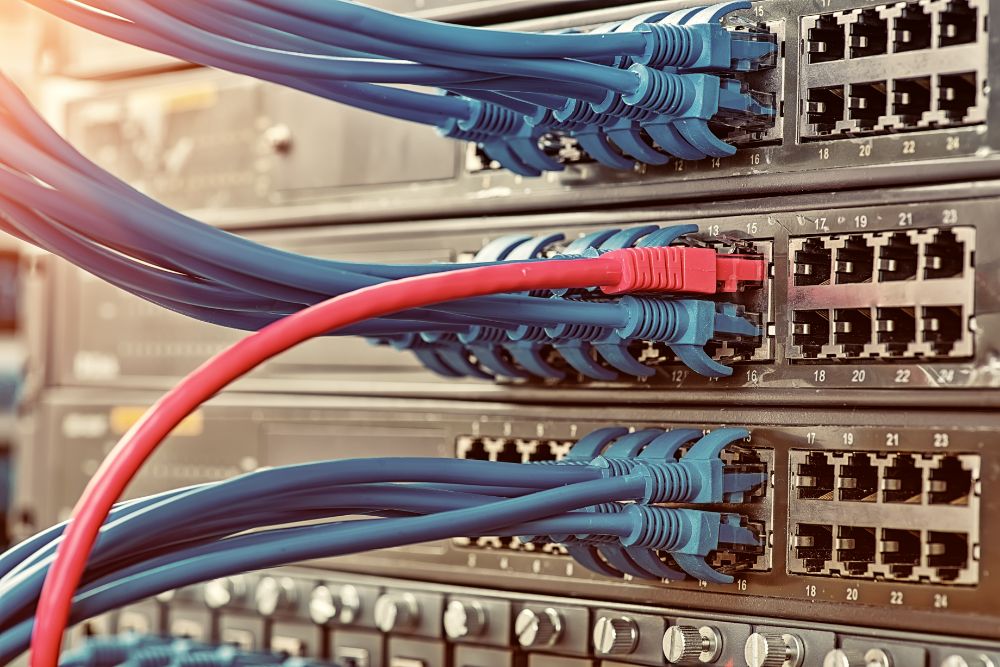Your network isn’t just important to you – it’s the lifeline of your business. That’s…

Mastering Networking Installation for Seamless Connectivity
Without a functioning network, your team can’t communicate, share essential data, or back up its work. Thanks to an effective network installation, your team can enjoy devices that connect within the organization. (Not to mention, networking installation makes your IT team happy, as it’s easy to deploy software updates within a network.)
Suffice it to say if your network isn’t functioning properly, that means big trouble for your business.
That said, deciding how to proceed with network installation is complex. To begin, you’ll need to decide what your network needs are. Then, you’ll create a comprehensive network design, which allows you to better understand what hardware is necessary—and how much of it.
The final step in getting set up is configuring your system to guarantee all your devices can communicate via the network. Of course, you’ll have to complete ongoing maintenance, too.
If that sounds complicated, it’s because it can be! We’re here to help walk you through everything you need about network installation. We’ll explain what a network is, the types, what you should consider, and the steps to installing an enterprise-level network.
What is a network?
You’ve probably heard the word ‘network’ before when meeting and connecting with new people in a business environment to potentially work together. That’s similar to the computer definition of a network, too.
A network is a group of interconnected devices that can connect, share, or exchange data. You may also be familiar with a network topology graph, which identifies the structure of how your devices connect.
It’s also important to note that there are several different types of networks: LAN, WAN, WLAN, and VPN. We’ll share more, but before we do, let’s dive into why understanding what a network does is essential before you install. Understanding network devices and their interaction will help you better select which type will work for your business.
Ready to learn more about the different types of networks? Let’s dive in.
Types of networks
We already know that, without a network, your team’s devices cannot connect and share or store essential data that enables your business to run successfully. There’s also a security component—without a functional network, your data is at risk of being attacked by cybercriminals.
Choosing the right type of network for your business can ensure your data is as safe as it can be.
Before we learn more about the different types of networks available, let’s quickly walk through the different networking components you should know.
These include:
- Router: Your network router is the backbone of the operation. This device both receives and sends data on your computer networks. You can think of it as a sort of hallway because that’s what it is: it enables data to pass through.
- Switch: A network switch is a piece of hardware responsible for connecting your devices using data packet switching. Thanks to the packet exchange process, it can receive or forward data to the destination.
- Cables: You can use network cables to connect your computers—you guessed it—to the network. This is obviously only necessary if you are building a wired network. In that case, you’ll need to connect devices using cables.
Local Area Network (LAN)
A local area network (LAN) refers to a group of devices together in a physical location. The signature feature of a LAN is that the devices are close together.
Because of this, you can opt to create wired networks since the computers are physically adjacent. This is an ethernet network in the purest sense, so if you’re interested in building a LAN, work with an ethernet network installation expert.
Wide Area Network (WAN)
A WAN is essentially the opposite; the network covers a large area and connects several LANs. The LANs can communicate with each other, however.
Wireless LAN (WLAN)
Here’s where things get interesting. Wireless LAN is a type of wireless network where the group is formed based on radio transmissions, not the physical presence of wires.
Virtual Private Network (VPN)
And last but certainly not least, we have the VPN. This is another network with wireless connectivity that is an appealing option because of the security it offers. A VPN encrypts your internet traffic to safeguard your identity, which makes it an attractive option for businesses looking to protect privacy.
It’s important to note that WiFi networks aren’t better or worse than ethernet ones—just different, and deciding which is more suitable for your needs comes down to preference.
What to consider before you start the installation
So, you’ve decided you want to move forward with networking installation. You’ll find that it’s a life-changing decision for your employees and an excellent idea for your business overall. Before you start the installation, we encourage you to ask certain questions so you can make sure you’re choosing the right option for you.
However, your first step really should be completing a pre-installation assessment. This is necessary to reduce the likelihood that your network will suffer any losses through the installation process.
Your assessment should give you insight into the network topology, traffic patterns, system requirements, and current security measures. Additionally, you should back up your data at this point—just in case something goes amiss in the installation process.
Once your office network is backed up and you’ve completed a pre-installation assessment, it’s time to ask yourself these questions:
- How many buildings, users, and devices will the network have? Certain types of networks are better for larger or more distributed teams.
- How many employees are remote versus in your buildings? A LAN network would suffice if your employees are all in one building. Or, if they’re spread out, a VPN may be a better choice, as they’ll need remote access. If employees can work remotely, you must consider this when selecting a network type.
- What applications will your users need to be included on the network? Ensure the applications your users need to be included on the network are compatible with their computers.
- Who needs to be involved for this to go smoothly? Maybe your IT department has it under control—or maybe your IT department is a team of one, and you’ll need to work with an external agency to establish your network.
- What kind of hardware is installed to create a network? Do you need new cables, or will you create a wireless network? If you don’t already have all the hardware you need, acquire it before you begin.
Enterprise network installation best practices
You’re almost ready to begin networking installation! However, before you do, checking out best practices will help set you up for success.
First, you’ll want to carefully consider cable management if you’re working with a LAN. Taking good care of your ethernet cables ensures your network cables will be able to support your network for years to come.
Before cutting up your office building walls to install ethernet cable, ensure you have a plan. Know where power outlets are, and keep in mind where your industrial facility’s electrical outlets are.
Additionally, it’s a good idea to keep track of your fiber optic cables. You may want to label them to figure out how they connect in the future. Plus, documenting this on a map will help you when you need to make updates. The better you keep track of your small business’s cables, the better off you’ll be.
Next, it’s a good idea to consider regular maintenance to keep your network settings up to par. Keep information about your network cables, wall plates, and access points in a central location so you can easily access them when questions arise.
You can even identify the cable lengths you used when you made the network so it’s easier to replace in the future. The better you take care of your network, the longer distances there will be in between replacing cables.
Steps to install an enterprise network
It’s time to install your enterprise’s network! Network configuration isn’t easy; we’ll give you that. However, if you are patient with network setup and take it one step at a time, you’ll find that creating your new network infrastructure isn’t as overwhelming as it initially seemed.
Step 1: Initial Planning
Your first step is to gather any tools and equipment necessary. If you’re building a local network, you’ll need ethernet cables.
Network cabling is how you’ll connect your devices, so these tools are necessary. If you’re building a LAN, you’ll also need a network switch.
For instance, if you’re building a VPN, having a reliable internet connection is key, as network connectivity issues spell trouble. As you can see, the tools you need vary depending on what type of network you seek.
Before you do anything to your existing network, you should take safety precautions, such as backing up your data. You can also make a network topology map demonstrating your current network structure. This can be helpful to refer back to.
Step 2: Choosing Your Network Equipment
The equipment you’ll need to build a LAN is much greater than if you’re building a WiFi network. Let’s walk through how you install routers, switches, cables, and network adapters.
To start, mark on your wall where you want the wall plates to go. This should be a thoughtful placement, so choose a spot that’s accessible, convenient, and not close to your power cables. Plus, be careful not to cut an electrical component or be too close to a light switch.
It’s essential you turn off the power in your building so just in case you do reach electrical wiring, you won’t get electrocuted. From there, cut a hole in the wall that will suit each wall plate. If you’re worried about messing something up, work with a contractor.
After, you will start to run the cable. Keep in mind that it’s necessary to run a line from the hub to each data point. You might need to get in the office’s ceiling or in a wall to do this. Be sure the electrical is off, or work with a professional to be safe.
Step 3: Physical Installation of Hardware
You’ve run your cable, now what? It’s time to test it. Strip the installation from the last two inches of the cable.
Then, take each wire to the corresponding terminal at the back of the wall terminal outlet. Attach them with a crimping tool. Then, use your network testing tool to make sure it’s working.
We can’t impress this upon you enough: if you aren’t confident doing this yourself, you should work with a professional to reduce the risk of injury—to yourself and your network.
Step 4: Configuring the Network
Part of your setup is also configuring your router. You can connect the computer to the router’s LAN ports using your ethernet cables.
Then, you’ll open a web browser and enter the router’s IP address in an address bar. Login to the router, change the password from the default, and configure your network settings.
You’ll also want to set up security measures such as a firewall. This ensures any incoming data packets are safe. Ultimately, when you set up your network, it’s your job to ensure your network connection will be safeguarded from predators.
Step 5: Network Testing and Troubleshooting
Last, use a network testing tool to ensure your network is properly configured. If not, the tool you use may provide greater insight into what’s wrong.
Then, return to that step of the process and rework it. Or, reach out to a fellow professional who can help you figure out where things went wrong.
Big takeaways and the importance of proper networking installation
As you can tell, a lot goes into network installation. That’s why working with network installation companies can streamline the process and simplify the entire experience. Not to mention, you’ll get your network up and running in record time.
Network Craze offers exceptional network installation services that will help your business create a functional, fully connected network. Reach out today if you want to learn more about how a better network can transform your business.





